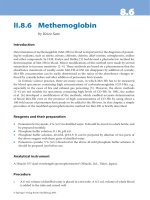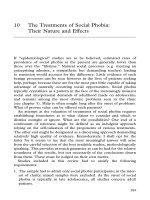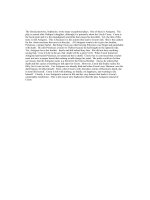Buckling of rectangular plates under intermediate and end loads
Bạn đang xem bản rút gọn của tài liệu. Xem và tải ngay bản đầy đủ của tài liệu tại đây (712.61 KB, 106 trang )
BUCKLING OF RECTANGULAR PLATES UNDER
INTERMEDIATE AND END LOADS
Chen Yu
NATIONAL UNIVERSITY OF SINGAPORE
2003
BUCKLING OF RECTANGULAR PLATES UNDER
INTERMEDIATE AND END LOADS
Chen Yu
(B. Eng.)
A THESIS SUBMITTED
FOR THE DEGREE OF MASTER OF ENGINEERING
DEPARTMENT OF CIVIL ENGINEERING
NATIONAL UNIVERSITY OF SINGAPORE
2003
ACKNOWLEDGEMENTS
The author wishes to express her sincere gratitude to Professor Wang Chien Ming, for
his guidance, patience and invaluable suggestions throughout the course of study. His
extensive knowledge, serious research attitude and enthusiasm have been extremely
valuable to the author.
Also special thanks go to Associate Professor Xiang Yang of University of Western
Sydney, Australia for his valuable discussions.
The author is grateful to the National University of Singapore for providing a
handsome research scholarship during the two-year study.
Finally, the author wishes to express her deep gratitude to her family, for their love and
continuous support during the course of this research.
i
TABLE OF CONTENTS
ACKNOWLEDGEMENTS
i
TABLE OF CONTENTS
ii
SUMMARY
iv
NOMENCLATURE
v
LIST OF TABLES
vii
LIST OF FIGURES
viii
CHAPTER 1: INTRODUCTION
1
1.1
Background
1
1.2
Literature Review
2
1.2.1
Elastic buckling of rectangular plates
2
1.2.2
Plastic buckling of rectangular plates
8
1.3
Objectives and Scope of Study
12
1.4
Outline of Thesis
13
CHAPTER 2: BUCKLING OF PLATES UNDER END LOADS
2.1
2.2
15
Elastic Buckling Theory
15
2.1.1
Derivation of differential equation for elastic buckling
15
2.1.2
Boundary conditions
19
Plastic Buckling Theory
2.2.1
20
Derivation of constitutive relations based on Hencky’s
deformation theory
20
Derivation of constitutive relations based on PrandtlReuss material
24
2.2.3
Derivation of differential equation for plastic buckling
25
2.2.4
Boundary conditions
27
2.2.2
ii
CHAPTER 3: ELASTIC BUCKLING OF PLATES UNDER
INTERMEDIATE AND END LOADS
3.1
3.2
3.3
31
Mathematical Modeling
32
3.1.1
Problem definition
32
3.1.2
Method of solution
32
Results and Discussions
38
3.2.1
SSSS plates
38
3.2.2
CSCS plate
41
3.2.3
FSFS plate
42
Concluding Remarks
43
CHAPTER 4: PLASTIC BUCKLING OF PLATES UNDER
INTERMEDIATE AND END LOADS
4.1
4.2
4.3
61
Mathematical Modeling
62
4.1.1
Problem definition
62
4.1.2
Method of solution
62
Results and Discussions
70
4.2.1
Effect of various aspect ratios a/b
72
4.2.2
Effect of various loading positions χ
74
4.2.3
Effect of various boundary conditions
74
4.2.4 Effect of various material properties
75
4.2.5
75
Effect of using two different theories
Concluding Remarks
CHAPTER 5: CONCLUSIONS AND RECOMMENDATIONS
75
88
5.1
Conclusions
88
5.2
Recommendations for Future Studies
89
REFERENCES
90
AUTHOR’S LIST OF PUBLICATIONS
95
iii
SUMMARY
This thesis is concerned with the new buckling problem of rectangular plates subjected
to intermediate and end uniaxial loads. The considered plate has two opposite simply
supported edges that are parallel to the load direction and the other remaining edges may
take any combination of free, simply supported or clamped condition. The
aforementioned buckling problem is solved by decomposing the plate into two sub-plates
at the location where the intermediate uniaxial load acts. Each sub-plate buckling
problem is solved exactly using the Levy approach and the two solutions brought
together by matching the continuity equations at the separated edge.
Both elastic and plastic theories have been used to formulate the problem. For the
elastic theory, there exists five possible solutions for each sub-plate. Thus, when we
combine the two sub-plate problems, we need to consider twenty-five possible different
solution combinations. It is found that the stability curves consist of a number of these
combinations depending on the boundary conditions, aspect ratios, and intermediate load
positions. For the plastic buckling part, two competing theories, namely incremental
theory and deformation theory have been adopted to bound the plastic buckling solutions.
Unlike its elastic counterpart, there are eight possible solutions for each sub-plate when
considering plastic buckling. Thus sixty-four possible solution combinations are
considered for the whole plate. The final solution combination depends on various ratios
of the intermediate load to the end load, the intermediate load locations, aspect ratios,
boundary conditions and material properties.
Extensive stability criteria curves were presented to elucidate the buckling behavior of
such loaded rectangular plates. The results will be useful for engineers designing walls or
plates that have to support intermediate floors/loads.
Keywords: Elastic buckling; Plastic buckling; Thin plate theory; Incremental Theory of
Plasticity; Deformation Theory of Plasticity; Rectangular plates; Intermediate load; Levy
method; Stability criteria.
iv
NOMENCLATURE
a
length of plates
b
width of plates
c
dimensionless constant describing the shape of the Ramberg-Osgood
stress-strain relation
D
flexural rigidity
E
Young’s modulus
G
shear modulus
H
plastic modulus
h
thickness of plates
k
horizontal distance between the knee of c = ∞ curve and the intersection
of the c curve with the σ / σ 0 = 1 line in the Ramberg-Osgood stress-strain
relation
M xx , M yy
bending moments per unit length on x and y planes
M xy
twisting moment per unit length on x plane
m
number of half waves of the buckling mode along y direction
n
number of half waves of the buckling mode along x direction
N1
end load on sub-plate 1 per unit length
N2
intermediate load on sub-plate 2 per unit length
Nx
uniaxial load on x plane
Qx
shear force per unit length on x plane
S
secant modulus
T
tangent modulus
U
strain energy
Vx
effective shear force per unit length
v
W
work done due to uniaxial loads
w
transverse deflection of a point on the mid-plane
α, β ,γ , ρ
parameters in incremental theory of plasticity and deformation theory of
plasticity
γ xy , γ yz , γ xz
shear strain in the xy, yz and xz plane
ε xx , ε yy
normal strain in x and y directions
η
contraction rate at current stress state
Λ1
end buckling load factor
Λ2
intermediate buckling load factor
ν
Poisson’s ratio
∏
potential energy
σ0
nominal yield stress
σ1
end buckling load stress
σ2
intermediate buckling load stress
σ xx , σ yy
normal stress on the x and y planes
σ xy
shear stress on the x plane and parallel to the y direction
σ
effective stress
χ
intermediate load position
φie ,ψ ie
parameters in elastic solutions
φi p ,ψ ip
parameters in plastic solutions
vi
LIST OF TABLES
Table 3.1
Twenty-five combinations of solutions
Table 3.2
Buckling factors Λ 2 for simply supported rectangular plates
35
subjected to inplane load in sub-plate 2 only ( N 1 = 0 )
41
Table 4.1
Types of solutions depending on values of ∆1 , ∆ 2 , ∆ 3
65
Table 4.2
Buckling stresses σ 1 for a simply supported, square plate under
uniaxial end load (i.e. no intermediate load)
Table 4.3
71
Comparison of buckling factors of full plates with uniaxial
intermediate and end loads and their corresponding end loaded
sub-plates with different interfacial edge conditions
73
vii
LIST OF FIGURES
8
Fig. 1.1
Fig. 1.1 Buckling of plates under(a) point loads; (b) partially
distributed loads; (c) patch loads at edge center; (d) patch loads
near corners.
Fig. 2.1
Thin rectangular plate under end uniaxial load
29
Fig. 2.2
Stress resultants on a plate element.
29
Fig. 2.3
Ramberg-Osgood stress-strain relation
30
Fig. 3.1
Geometry and coordinate systems for rectangular plate
subjected to intermediate and end uniaxial inplane loads. (a)
Original plate; (b) Sub-plate 1; and (c) Sub-plate 2
45
Fig. 3.2
Typical stability criterion curves for SSSS plates subjected to
end and intermediate inplane loads: (a) plate with integer
aspect ratio a/b, and (b) plate with non-integer aspect ratio a/b.
46
Fig. 3.3
Stability criteria for SSSS rectangular plates with (a) a/b = 1.0,
(b) a/b = 1.5, and (c) a/b = 2.0.
48
Fig. 3.4
Variations of buckling intermediate load factor Λ 2 with
respect to location χ for SSSS square plate (Note that
Λ cr = 4.0000 is the buckling load factor for square SSSS plate
under end load only).
49
Fig. 3.5
Normalized modal shapes and modal moment distributions in
the x-direction for SSSS square plate subjected to intermediate
load N2 (N1 = 0): (a) modal shapes; and (b) modal moment
distributions
50
Fig. 3.6
Variation of buckling factors Λ2 versus plate aspect ratio a/b
for SSSS plates subjected to inplane load in sub-plate 2 only.
51
Fig. 3.7
Stability criteria for CSCS rectangular plates with plate aspect
ratios (a) a/b = 1.0, (b) a/b = 1.5, and (c) a/b = 2.0.
53
Fig. 3.8
Variations of buckling intermediate load factor Λ 2 with
respect to location χ for CSCS square plate
54
Fig. 3.9
Variations of buckling factors Λ2 versus plate aspect ratio a/b
for CSCS rectangular plates subjected to inplane load in subplate 2 only.
55
Fig. 3.10
Typical stability criterion curve for FSFS rectangular plates
subjected to end and intermediate inplane loads.
56
Fig. 3.11
Stability criteria for FSFS rectangular plates with plate aspect
ratios (a) a/b = 1.0, (b) a/b = 1.5, and (c) a/b = 2.0.
58
viii
Fig. 3.12
Variations of buckling intermediate load factor Λ2 with respect
to location χ for FSFS square plate
59
Fig. 3.13
Variations of buckling factors Λ2 versus plate aspect ratio a/b
for FSFS rectangular plates subjected to inplane load in subplate 2 only.
60
Fig. 4.1
Rectangular plate under intermediate and end uniaxial loads
77
Fig. 4.2
Typical stability criterion curve
77
Fig. 4.3
Stability criteria for SSSS rectangular plates with h/b = 0.04
and different aspect ratios a/b = 1, 2, 3 by (a) IT and (b) DT.
The intermediate load is placed at χ = 0.5
78
Fig. 4.4
Stability criteria for CSCS rectangular plates with h/b = 0.04
and different aspect ratios a/b = 1, 2, 3 by (a) IT and (b) DT.
The intermediate load is placed at χ = 0.5
79
Fig. 4.5
Stability criteria for FSFS rectangular plates with h/b = 0.04
and different aspect ratios a/b = 1, 2, 3 by (a) IT and (b) DT.
The intermediate load is placed at χ = 0.5
80
Fig. 4.6
Rectangular plate YSZS and the corresponding sub-plate YSXS
under uniaxial load
81
Fig. 4.7
Variation of buckling factors Λ 2 with respect to χ for
rectangular plates with Λ 1 =0 and 2 by (a) IT (b) DT.
Fig. 4.8
Stability criteria for rectangular plates with h/b = 0.04, aspect
ratio a/b = 2, intermediate load position χ = 0.5 and different
boundary conditions by (a) IT and (b) DT
83
Fig. 4.9
Stability criteria for SSSS square plates with h/b = 0.04, χ =
E
0.5, for different
= (a) 200, (b) 400, (c) 800 by IT
85
Stability criteria for SSSS square plates with h/b = 0.04, χ =
E
= (a) 200, (b) 400, (c) 800 by DT
0.5, for different
86
Buckling load factors Λ 2 for SSSS square plates with Λ 1 = 0
87
82
σ0
Fig. 4.10
σ0
Fig. 4.11
ix
Chapter 1
INTRODUCTION
1.1
Background
Plates are widely used in many engineering structures such as aircraft wings, ships,
buildings, and offshore structures. Most plated structures, although quite capable of
carrying tensile loadings, are poor in resisting compressive forces. Usually, the buckling
phenomena observed in compressed plates take place rather suddenly and may lead to
catastrophic structural failure. Therefore it is important to know the buckling capacities
of the plates in order to avoid premature failure.
The first significant treatment of plate buckling occurred in the 1800s. Based on
Kirchhoff assumptions, the stability equation of rectangular plates was derived by Navier
(1822). Since then, investigations on the buckling of plates with all sorts of shapes,
boundary and loading conditions have been reported in standard texts (e.g. Timoshenko
and Gere 1961, Bulson 1970), research reports (e.g. Batdorf and Houbolt 1946) and
technical papers (e.g. Wang et al. 2001; Xiang et al. 2001). Research on the buckling of
plates may be categorized under elastic buckling and plastic buckling. In the elastic
buckling research, it is assumed that the critical load remains below the elastic limit of
the plate material. However, in practical problems the plate may be stressed beyond the
elastic limit before buckling occurs. Therefore, buckling theories of plasticity are
Chapter 1
Introduction
2
introduced for practical uses. Generally there are two competing plastic theories, namely,
the deformation theory (DT) and the incremental theory (IT) of plasticity.
The buckling of rectangular plates under intermediate and end loads has hitherto not
been treated. The present study tackles such a problem by considering both elastic
buckling and the plastic buckling behavior of these loaded problems.
1.2
Literature Review
In the following, a literature review on the bucking of rectangular plates is presented to
provide the background information for the present investigation. The review focuses on
homogenous, isotropic, thin plates. Studies on sandwich, composite and orthotropic
plates are not covered.
1.2.1 Elastic buckling of rectangular plates
This part is concerned with the research done for the elastic buckling of rectangular
plates under various in-plane loads and boundary conditions for the plate edges.
Navier (1822) derived the basic stability equation for rectangular plates under lateral
load by including the twisting action. The inclusion of the ‘twisting’ term is very
important because the resistance of the plate to twisting can considerably reduce
deflections under lateral load. Saint-Venant (1883) modified the equation by including
axial edge forces and shearing forces. The modified equation formed the basis for much
of the work on plate stability of plates with various loads and boundary conditions.
Chapter 1
Introduction
3
• Buckling of plates under uniaxial compression
The most basic form of plate buckling problem is a simply supported plate under
uniaxial compression. Bryan (1891) gave the first solution for the problem by using the
energy method to obtain the values of the critical loads. He assumed that the deflection
surface of the buckled plate could be represented by a double Fourier series. Timoshenko
(1925) used another method to solve the problem. He assumed that the plate buckled into
several sinusoidal half waves in the direction of compression. When satisfying the
boundary conditions, the equations formed a matrix problem which upon solving yields
the critical load. The problem was discussed in many standard textbooks such as
Timoshenko and Gere (1961) and Bulson (1970).
Apart from simply supported plates, Timoshenko (1925) explored the buckling of
uniformly compressed rectangular plates that are simply supported along two opposite
sides perpendicular to the direction of compression and having various edges along the
other two sides. The various boundary conditions considered include SSSS, CSCS, FSSS,
FSCS, CSES (S - simply supported edge, F - free edge, C - clamped or built-in edge and
E - elastically restrained edge). The theoretical results were in good agreement with
experimental results obtained by Bridget et al. (1934). Lundquist and Stowell (1942) used
the integration method to solve ESES plates by assuming that the surface deflection was
the sum of a circular arc and a sine curve. They also discussed the critical load of ESFS
plates by both integration method and the energy method by assuming that transverse
deflection was the sum of a straight line and the cantilever deflection curve. Schleicher
(1931) gave the theoretical solution by using the integration method for CSCS plate with
the loaded edges clamped. The earliest accurate solution available is due to Levy (1942)
Chapter 1
Introduction
4
for the case of CCCC plate with one direction uniaxial compression. He regarded the
plate as simply supported, and then made the edge slopes equal to zero by a suitable
distribution of edge-bending moments. Bleich (1952) obtained the critical load for the
ESES plates with loaded edges elastically restrained. The results are for the symmetric
mode only and values of aspect ratio are less than 1.0.
For the elastic buckling of rectangular plates with linearly varying axial compression
there is no exact analytical solution. For these cases, recourse is made by considering the
energy or similar method, based on an assumed deflected form. The best-known analysis
for simply supported plates is due to Timoshenko and Gere (1961), who employed the
principle of conservation of energy and assumed the buckled form of the plate consisted
of several half-waves in the loading direction. Kollbrunner and Hermann (1948)
examined the CSSS plates. They found when the clamped edge is on the tension side of
the plate, the critical load factors do not differ greatly from those with both edges simply
supported. Schuette and Mcculloch (1947) employed the Lagrangian multiplier to solve
the buckling problem of ESSS plates. Walker (1967) used the Galerkin’s method to give
accurate values of critical load for a number of the edge conditions as mentioned before.
He also studied the case of ESFS plates. Xiang et al. (2001) considered the elastic
buckling of a uniaxially loaded rectangular plate with an internal line hinge. Using the
Levy’s method, they succeeded in presenting the exact solution for many different
boundary conditions such as SSSS, FSFS, CSCS, FSSS and SSCS plates.
• Buckling of plates under biaxial compression
Bryan (1891) first considered the SSSS plates under biaxial compressions by assuming
that the deflection could be written as a double Fourier series. Wang (1953) solved the
Chapter 1
Introduction
5
same problem by finite-difference method. Timoshenko and Gere (1961) solved the
CCCC plates under two-direction loads by the energy method. Bulson (1970) cited many
research works on the buckling problem of plates under biaxial compressions. One
example is a rigorous analysis for ESFS plates by using the exact solution of the
differential equation of equilibrium. An extra term in the equation of equilibrium was
added to allow for the transverse force. It is found that the effect of a restraint along one
side ranged between simply supported and clamped boundary condition. Another
example is for examining the FSFS plates by using two buckling forms, i.e. symmetric
and anti-symmetric forms. It is worth noting that the buckling loads associated with the
symmetric buckling form were much lower than those of anti-symmetric form.
Xiang et al. (2003) used the Ritz method to solve the buckling problem of rectangular
plates with an internal line hinge under both uniaxial and biaxial loads. The buckling
factors are generated for rectangular plates of various aspect ratios, hinge locations and
support conditions.
• Buckling of plates under in-plane shear forces
Wang (1953) and Timoshenko and Gere (1961) applied the energy method to solve the
buckling problem of SSSS plates under in-plain shear forces. Since it is not possible to
make assumptions about the number of half-waves, Timoshenko assumed that the
deflection surface was taken in the form of infinite series. Timoshenko and Gere (1961)
studied further to consider SSCC plates and also the behavior of an infinitely long plate
subjected to shear forces. Lundquist and Stowell (1942) examined the ESES plates by
employing the energy method, and also the exact analysis to solve the differential
Chapter 1
Introduction
6
equation of equilibrium. More recently, Reddy (1999) applied the Rayleigh-Ritz
approximation to solve the CCCC plates under shear forces.
• Buckling of plates under combined loads
Batdorf and Stein (1947) evaluated the buckling problem under combined shear and
compression combinations for simply supported plates by adopting the deflection
function in the form of infinite series. Batdorf and Houbolt (1946) gave a solution to the
equation of equilibrium for infinitely long plates with restrained edges under shear and
uniform transverse compression. Johnson and Buchert (1951) used the energy method to
explore the buckling behavior of rectangular plates with compression edge simply
supported or elastically restrained, tension edge simply supported. Researchers who are
interested in this field of research may refer to Bulson (1970), in which many research
papers were cited. More recently, Kang and Leissa (2001) presented exact solutions for
the buckling of rectangular plates having two opposite, simply supported edges subjected
to linearly varying normal stresses causing pure in-plane moments, the other two edges
being free.
• Buckling of plates under body forces
Farvre (1948) is probably the first researcher to work out approximate buckling
solutions of rectangular plates under selfweight and uniform in-plane compressive forces.
However, he treated only plates with all four edges simply supported. Wang and Sussman
(1967) solved the same problem using the Rayleigh-Ritz method and concluded that the
average stress in the plate at buckling is less than that for a plate with uniform
compression at buckling. Both Favre (1948) and Wang and Sussman (1967) did not give
numerical values in their papers. Using the conjugate load-displacement method, Brown
Chapter 1
Introduction
7
(1991) investigated the buckling of rectangular plates under (a) a uniformly distributed
load, (b) a linearly increasing distributed load and (c) a varying sinusoidal load across the
plate width. The second type of load is equivalent to the plate’s selfweight. In his study,
Brown treated a number of combinations of boundary conditions. More recently, Wang et
al. (2002) considered the buckling problem of vertical plates under body
forces/selfweight. The vertical plate is either clamped or simply supported at its bottom
edge while its top edge is free. The two sides of the plate may either be free, simply
supported or clamped. Xiang et al. (2003) treated yet another new elastic buckling
problem where the buckling capacities of cantilevered, vertical, rectangular plates under
body forces are computed.
• Buckling of plates under other forms of loads
Bulson cited Yamaki’s buckling studies on SSSS, CSCS and CCCC plates under equal
and opposite point loads as shown in Fig. 1.1a. Bulson (1970) also cited Yamaki’s
research on buckling problems of CSCS and SSSS plates under partially distributed
loads which are acted upon the simply supported edges as shown in Fig. 1.1b. Lee et al.
(2001) considered the elastic buckling problem of square EEEE and ESES plates
subjected to in-plane loads of different configurations acting on opposite sides of plates
as shown in Figs 1.1c and 1.1d. The effects of Kinney’s fixity factor (introduced to
describe the support conditions at the edges covering the boundary conditions of simply
supported and fixed edges) and the width factor on critical load factors were treated.
Chapter 1
Introduction
q
q
8
simply
supported
q
(a)
(b)
q/χ
q
q
q/χ
q
0.5χL
χL
L
0.5χL
L
(c)
L
(d)
Fig. 1.1 Buckling of plates under (a) point loads; (b) partially
distributed loads; (c) patch loads at edge center; (d) patch loads
near corners.
1.2.2 Plastic buckling of rectangular plates
This part is concerned with the development of the plastic stability theories.
Incremental theory of plasticity (IT) and the deformation theory of plasticity (DT) are
considered in detail. As an alternative method, the strip method is also briefly reviewed.
The earliest development of DT is due to Engesser (1895) and Von Karman (1910).
They developed a theory based on the fact that for a fiber which is compressed beyond
the elastic limit, the tangent modulus (i.e. the ratio of the variation of strain to the
corresponding variation of stress) assumes different values depending on whether the
variation of stress constitutes an increase or a relief of the existing compressive stress.
Chapter 1
Introduction
9
Bleich (1924) and Timoshenko (1936) applied Engesser-Von Karman theory to the
plastic buckling of plates by introducing the “reduced modulus” into the formulas for the
elastic buckling of plates. The results of their theory were obtained in the case of a
narrow rectangular strip with its compressed short edge simply supported and the long
edges free.
Kaufmann (1936) and Ilyushin (1944) developed the basis of deformation theory of
plasticity by presenting another route for application of Engesser-Von Karman theory.
They went back to the considerations by which the reduced modulus was derived and
applied to the case of buckled a plate. Ilyushin (1946) reduced the problem to the solution
of two simultaneous nonlinear partial differential equations of the fourth order in the
deflection and stress function, and in the approximate analysis to a single linear equation.
Solutions were given for the special cases of a rectangular plate buckling into a
cylindrical form, and of an arbitrarily shaped plate under uniform compression. Stowell
(1948) assumed that the plate remained in the purely plastic state during buckling. He
used Ilyushin’s general relations to derive the differential equation of equilibrium of
plates under combined loads. The corresponding energy expressions were also found.
Bijlaard (1949) also used the assumption of “plastic deformation”. He derived the stressstrain relations by writing the infinitely small excess strains as total differentials and
computing the partial derivatives of the strains with respect to the stresses. The
differential equation for plate buckling was derived and results of its application to
several kinds of loading and boundary conditions were given. El-Ghazaly and Sherbourne
(1986) employed the deformation theory for the elastic-plastic buckling analysis of plates
under non-proportional external loading and non-proportional stresses. Loading,
Chapter 1
Introduction
10
unloading, and reloading situations were considered. Comparison between experiments
and analysis results showed that the deformation theory of plasticity was applicable in
situations involving plastic buckling under non-proportional loading and non-uniform
stress fields.
The incremental theory of plasticity was first developed in the early work by
Handelman and Prager (1948). They assumed that for a given state of stress there existed
a one-to-one correspondence between the rates of change of stress and strain in such a
manner that the resulting relation between stress and strain cannot be integrated so as to
yield a relation between stress and strain along. Pearson (1950) modified Handelman and
Prager’s assumption of initial loading. His analytical results showed that the incremental
was improved by incorporating Shanley’s concept of continuous loading.
Deformation theory and incremental theory of plasticity are two competing plastic
theories. Consequently much work and comparison studies have been done by using both
of them. Shrivastava (1979) analyzed the inelastic buckling by including the effects of
transverse shear by both theories. Three cases were discussed: (1) for infinitely long
simply supported plates, (2) for square simply supported plates, and (3) for infinitely long
ones simply supported on three sides and free on one unloaded edge. Ore and Durban
(1989) presented a linear buckling analysis for annular elastoplastic plates under shear
loads. They found that deformation theory predicts critical loads which were considerably
below the predictions obtained with the flow theory. Furthermore, comparison with
experimental data for different metals showed a good agreement with the deformation
theory. Tugcu (1991) employed both theories for simply supported plates under biaxial
loads. It was shown that the incremental theory predictions for the critical buckling stress
Chapter 1
Introduction
11
were susceptible to significant reductions due to a number of factors pertinent to testing,
while the deformation theory analysis was shown to be more or less insensitive to all of
these factors. Durban and Zuckerman (1999) examined the elastoplastic buckling of a
rectangular plate with three sets of boundary conditions (four simply supported
boundaries and the symmetric combinations of clamped/simply supported sides). It was
found that for thicker plates, the deformation theory gives lower critical stresses than
those obtained from the incremental theory.
There is a general agreement among engineers and researchers that (a) deformation
theory is physically less correct than incremental theory, but (b) deformation theory
predicts buckling loads that are smaller than those obtained with incremental theory, and
(c) experimental evidence points in favor of deformation theory results. Onat and
Drucker (1953) through an approximate analysis showed that incremental theory
predictions for the maximum support load of long plates supported on three sides will
come down to the deformation theory bifurcation load if small but unavoidable
imperfections were taken into account. Later, the plate buckling paradox was examined
by Sewell (1963) who obtained somewhat lower flow theory buckling loads by allowing
a variation in the direction of the unit normal. Sewell (1973) in a subsequent study
illustrated that use of Tresca yield surface brings about significant reductions in the
buckling loads obtained using incremental theory. Neale (1975) examined the sensitivity
of maximum support load predictions to initial geometric imperfections, using
incremental theory. A similar study was performed by Needleman and Tvergaard (1976)
which also included the effect of in-plane boundary conditions for square plates under
uniaxial compression. An exhaustive discussion of the buckling paradox in general is
Chapter 1
Introduction
12
given by Hutchinson (1974). While imperfection sensitivity provided a widely accepted
explanation for the buckling paradox in general, reservations concerning the mode and
amplitude of the imposed imperfections for some buckling problems are not uncommon.
Readers who are interested in plastic buckling of plates may obtain further information
from these published papers: Shrivastava (1995), Betten and Shin (2000), Soh et al.
(2000), Chakrabarty (2000), Wang et al. (2002) and Wang (2003).
From the literature review above, we can see that although much work has been done,
the buckling of rectangular plates subjected to end and intermediate loads remain hitherto
untouched. This has prompted the author to work on this project.
1.3
Objectives and Scope of Study
The buckling of rectangular plates with various plate boundary and load conditions has
been studied extensively and there is an abundance of buckling results in the open
literature. However, a new plate buckling problem where a rectangular plate is subjected
to not only end loads, but also an intermediate uniaxial load remains to be studied.
The aim of the study is to determine the buckling factors of rectangular plates under
intermediate and end loads. The considered plates have two opposite simply supported
edges that are parallel in direction to the applied uniaxial loads while the other two
remaining edges may take any other combinations of clamped, simply supported and free
edge. Both elastic theory and plastic theories including incremental theory (IT) and
deformation theory (DT) are used to explore the problem. Further the study investigates
the effects of various plate aspect ratios, intermediate load positions, boundary conditions,
Chapter 1
Introduction
13
and material properties on the buckling factors. In the plastic buckling of plates, the
differences between results by IT and DT are examined.
1.4
Outline of Thesis
In this Chapter 1, the background information, literature review, objectives and scope
of the study are presented.
In Chapter 2, the governing equations are derived for both elastic and plastic buckling
of rectangular plates under uniaxial end loads. Equations for various boundary conditions
are also presented.
Chapter 3 is concerned with the elastic buckling of rectangular plates subjected to
intermediate and end uniaxial in-plane loads. The plate has two opposite simply
supported edges that are parallel to the load direction and the other remaining edges may
take any combination of free, simply supported or clamped condition. The buckling
problem is solved by decomposing the plate into two sub-plates at the location where the
intermediate uniaxial load acts. Each sub-plate buckling problem is solved exactly using
the Levy approach and the two solutions brought together by matching the continuity
equations at the interfacial edge. There are five possible solutions for each sub-plate and
consequently there are twenty-five combinations of solutions to be considered. The
effects of various aspect ratios, intermediate load positions and boundary conditions are
investigated.
In Chapter 4 we extend the elastic buckling problem to the more practical plastic
buckling of plates. Both the Incremental Theory of Plasticity and the Deformation Theory
of Plasticity are considered in bounding the plastic behavior of the plate. In contrast to the
Chapter 1
Introduction
14
five possible solutions for the elastic problem, there exist eight possible solutions for each
sub-plate. Consequently, there are sixty-four combinations of solutions to be considered
for the entire plate. The solution combination depends on the aspect ratios, the
intermediate load positions, the intermediate to end load ratios, the material properties
and the boundary conditions. The effects of the aforementioned parameters and the
adoption of DT and IT on the buckling factors are also investigated.
Finally, Chapter 5 summarizes the main research findings in conclusions. Suggestions
for future investigations are also provided.









